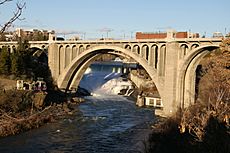Monroe Street Bridge (Spokane River) facts for kids
Quick facts for kids Monroe Street Bridge |
|
|---|---|

View from southwest in 2007
|
|
| Coordinates | 47°39′38″N 117°25′36″W / 47.6605°N 117.4267°W |
| Crosses | Spokane River |
| Locale | Spokane, Washington, U.S. |
| Characteristics | |
| Design | Decked-arch bridge |
| Material | Reinforced concrete |
| Total length | 896 ft (273 m) |
| Width | 50 ft (15 m) roadway with 9 ft (2.7 m) sidewalks |
| Height | 136 ft (41.5 m) |
| Longest span | 281 ft (85.6 m) |
| History | |
| Construction cost | $500,000 (1911) $18 million (2003–2005 restoration) |
| Opened | November 23, 1911 |
| Rebuilt | 2003–2005 |
| Lua error in Module:Location_map at line 420: attempt to index field 'wikibase' (a nil value). | |
The Monroe Street Bridge is a famous arch bridge in Spokane, Washington. It crosses the Spokane River in the Northwestern United States. This bridge was built in 1911 by the city of Spokane.
It was designed by city engineer John Chester Ralston. When it was finished, it was the largest concrete arch bridge in the United States. It was also the third longest concrete arch bridge in the world! After working for over 90 years, the bridge was closed for repairs in 2003. It reopened in 2005, looking like new.
Contents
Bridge History and Design
The Monroe Street Bridge you see today is actually the third bridge built in this spot. The very first bridge was made of wood in 1889. It was not very strong and burned down in 1905.
The design for the current bridge was inspired by other famous bridges. It was similar to the Rocky River Bridge in Cleveland, Ohio. The Spokane bridge was made one foot longer to be the biggest concrete arch bridge in the U.S. at that time.
The bridge has cool decorations like bison skulls and covered areas. A man named P. C. Shine found the idea for the bison skulls in Alberta, Canada. The bridge is located just west of Spokane Falls and opened on November 23, 1911.
Modernizing the Bridge
Over the years, the Monroe Street Bridge was updated. In 1925, the lamps on the bridge were changed to electric lights. In 1934, the tracks for electric streetcars were removed from the bridge.
In 1976, the bridge was added to the National Register of Historic Places. This means it is an important historical landmark.
Restoring the Bridge for the Future
By the 1990s, the bridge was getting old and needed major repairs. In January 2003, workers carefully took parts of the bridge apart. They rebuilt it to look exactly like it did when it was new.
The bridge reopened on September 17, 2005. It now has new railings and strong concrete barriers. These separate the sidewalks from the road, making it safer for everyone.
Images for kids





